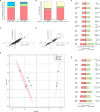TMT-Based Multiplexed Quantitation of N-Glycopeptides Reveals Glycoproteome Remodeling Induced by Oncogenic Mutations
- PMID: 35415375
- PMCID: PMC8991921
- DOI: 10.1021/acsomega.1c06970
TMT-Based Multiplexed Quantitation of N-Glycopeptides Reveals Glycoproteome Remodeling Induced by Oncogenic Mutations
Abstract
Glycoproteomics, or the simultaneous characterization of glycans and their attached peptides, is increasingly being employed to generate catalogs of glycopeptides on a large scale. Nevertheless, quantitative glycoproteomics remains challenging even though isobaric tagging reagents such as tandem mass tags (TMT) are routinely used for quantitative proteomics. Here, we present a workflow that combines the enrichment or fractionation of TMT-labeled glycopeptides with size-exclusion chromatography (SEC) for an in-depth and quantitative analysis of the glycoproteome. We applied this workflow to study the cellular glycoproteome of an isogenic mammary epithelial cell system that recapitulated oncogenic mutations in the PIK3CA gene, which codes for the phosphatidylinositol-3-kinase catalytic subunit. As compared to the parental cells, cells with mutations in exon 9 (E545K) or exon 20 (H1047R) of the PIK3CA gene exhibited site-specific glycosylation alterations in 464 of the 1999 glycopeptides quantified. Our strategy led to the discovery of site-specific glycosylation changes in PIK3CA mutant cells in several important receptors, including cell adhesion proteins such as integrin β-6 and CD166. This study demonstrates that the SEC-based enrichment of glycopeptides is a simple and robust method with minimal sample processing that can easily be coupled with TMT-labeling for the global quantitation of glycopeptides.
© 2022 The Authors. Published by American Chemical Society.
Conflict of interest statement
The authors declare no competing financial interest.
Figures





References
-
- Carvalho S.; Catarino T. A.; Dias A. M.; Kato M.; Almeida A.; Hessling B.; Figueiredo J.; Gartner F.; Sanches J. M.; Ruppert T.; Miyoshi E.; Pierce M.; Carneiro F.; Kolarich D.; Seruca R.; Yamaguchi Y.; Taniguchi N.; Reis C. A.; Pinho S. S. Preventing E-cadherin aberrant N-glycosylation at Asn-554 improves its critical function in gastric cancer. Oncogene 2016, 35 (13), 1619–31. 10.1038/onc.2015.225. - DOI - PMC - PubMed
LinkOut - more resources
Full Text Sources
Research Materials
Miscellaneous

